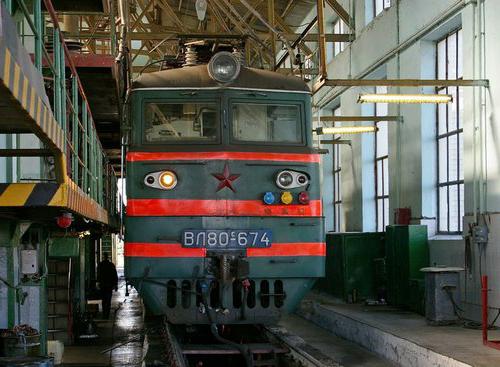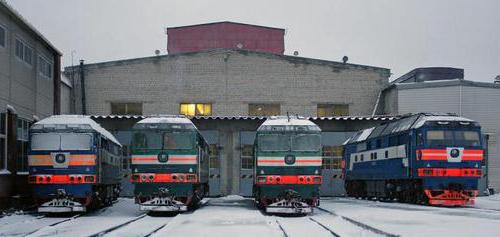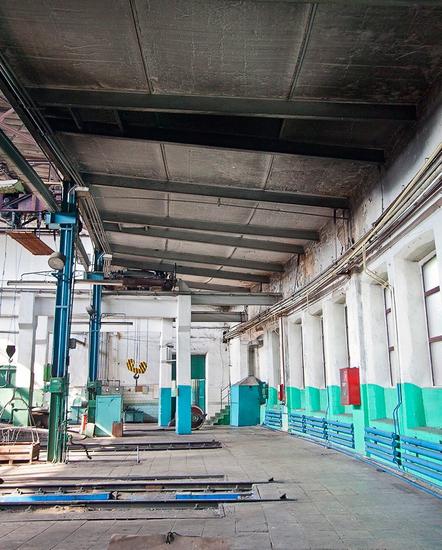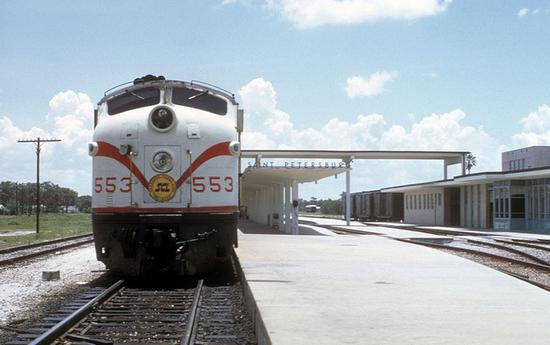On July 30, 2015, the grand opening of the most modern multi-unit car depot in Russia took place, where electric trains of the new generation undergo all types of technical and service maintenance. The location of the depot in the center of the Moscow railway junction and the ongoing reconstruction of the Small Ring ensure the departure of rolling stock in all directions. The repair base is concentrated in one place, which makes it possible to improve the quality of repairs and the reliability of electric trains, and to reduce the costs of maintenance of the rolling stock.
The Podmoskovnaya motor car depot of the Moscow directorate for the organization of high-speed traffic is the most modern motor car depot in Russia, where the new generation Lastochka electric trains will undergo all types of technical and service maintenance. The repair base is concentrated in one place, which makes it possible to improve the quality of repairs and the reliability of electric trains, and to reduce the costs of maintenance of the rolling stock. Already today, the new depot allows for planned and unplanned views Maintenance 88 train sets. And in the future, the number of serviced electric trains can be increased to 294. In addition, the depot will become a center for training personnel for high-speed trains.
The technological solutions of the new multi-unit depot for maintenance and repair of electric trains were based on the most modern technological solutions. - Elevated track for inspecting the rolling stock and its undercarriage; - Devices with track bridges for the replacement of wheelsets and undercar equipment, allowing the equipment to be changed without uncoupling the electric train. These complex operations during the maintenance of the train can be carried out without the use of special jacking positions: the equipment is lowered and raised power plant moving inside the overpass. This technology has been applied for the first time. The simplicity of the technical solution made it possible to reduce downtime, costs during the construction and operation of technological equipment.
- Stationary suspended two-level platforms for access to the electric train and retractable platforms for safe access to the roof of the electric train. For access to the electric train, rolling platforms are used; - System of a tap-off contact wire and radio-controlled cranes;
- The use of mobile jacks that provide the ability to lift both a coupled Lastochka electric train and individual cars;
- Mobile installations for filling with sand;
- Devices for power supply of the train from an external power source, allowing the rolling stock to be powered for a period of long stand-by or maintenance;
- A machine for turning wheelsets of the "Tandem" type, which allows turning two wheelsets with a different base of bogies of "Lastochka" trains, as well as various types of locomotives without rolling out from under the train;
- Installation for washing rolling stock, which allows washing the train while moving on its own from the contact network, which significantly reduces the time for the operation;
- The multi-unit depot complex is equipped with recycling water supply systems, a rainwater treatment system has been used for washing electric trains and irrigating the depot territory;
- To clean dry closets, a mobile module is used, which allows you to perform all operations without rearranging the composition to a separate position, in parallel with performing maintenance. The capacity of one unit is sufficient to service all electric trains undergoing technical maintenance at the depot.
The locomotive depot is a point where maintenance or repair work is carried out on trains. It is also called the traction part.
General information
Locomotive depots fall into two categories. They can be basic and negotiable. The first ones are intended for registering steam locomotives. Secondly, the preparation of locomotives is carried out, which follow to the main (operational) locomotive depot. The turnaround point is intended for maintenance of steam locomotives. They also carry out an inspection of the second volume. There are rest homes for staff. Currently, the repair locomotive depot is also allocated to a separate category. Objects of this type do not have a registered locomotive fleet. At the same time, such depots carry out large renovation work that are aimed at meeting the needs of one or more railways.
Historical information. Features of construction
The operational locomotive depot has always been an integral part of the railways. The construction of such an object depended on many factors. For example, on the complexity of the profile section of the Russian Railways. The locomotive depot was to be built at a certain distance from the neighboring one. As a rule, there were fifty to one hundred kilometers between them. Traction parts were located in a special way on the line connecting the capital of Russia and St. Petersburg. The main locomotive depot was located next to the revolving depot. The estimated traffic intensity on the site determined the number of locomotive stalls. At the initial stage, car repairs were also carried out at the depot. Several years after the opening of the railways, changes were required. The workshop and the locomotive depot became independent enterprises. Until 1933, a single service managed all elements of the system. Later, the government decided that the wagon economy would become an independent industry. railway transport. 
New classification
Locomotive depots had this name until the transition to the use of diesel and electric traction. After that, the points received at their disposal several types of locomotives. Diesel and electric locomotives were delivered here. Then the name changed. Each point became known as a "locomotive depot" after several electric locomotives, diesel locomotives and steam locomotives were at their disposal. Those points that had a registered fleet began to be called motor wagons. They also carried out the repair and operation of diesel and electric trains. As a rule, there were several maneuverable diesel locomotives. These points were also called "elektrodepo". The general term used to name these objects is a locomotive economy.
Further development
In the 70s. the number of locomotive fleets increased, as the volume of traffic increased significantly. Some of the major stations numbered more than two hundred trains. The depots could no longer provide high-quality service for all types of locomotives. At that time, the points began to specialize in the maintenance of individual series. Some depots carried out "lifting" work to meet the needs of locomotive stations along the entire length of the road, and in some cases even several. Uninterrupted operation required equipping with the necessary equipment, such as bench and machine tools. The priority was given to the supply of spare parts. 
Introducing new categories
The combination of the above factors and the site where this or that locomotive depot was located became the reason for the next divisions. The traction parts were divided into the following categories by purpose: maneuverable, multi-unit, passenger and cargo. The latter were located at large marshalling and junction stations. Passenger depots were located on the corresponding sections of the railway. Few items are narrowly specialized. The main locomotive depot in most cases can play the role of a turnaround. It can also perform other functions. For example, many locomotive points Sennoy, Rtishchevo and are turnover for Saratov. Most depots perform several functions. For example, locomotive points can simultaneously be maneuverable, freight and passenger. Those in the 80s. were locomotive depots in Moscow, Rtishchevo, Saratov, Volgograd and Orenburg. The latter functions in this mode to this day. 
Functioning during the USSR period
At that time, the locomotive depot had a preventive maintenance system. This structure involved carrying out the relevant work, taking into account the standards of the overhaul mileage. The locomotive depot faced many challenges. To solve them in a timely manner, it was necessary to place the following elements on the territory of the points.
- Fuel warehouse. It is designed to store stocks of various lubricants, oils and fuels.
- Service center. It is needed to equip locomotives and repair them.
- Swivel triangle or circle. It is designed to carry out technological or periodic locomotive turn.
- Equipment point. Most often it is combined with a locomotive maintenance center.
- Repair shop. It is designed for major renovation works.
- Auxiliary items. They are necessary for the repair of individual units and units of the locomotive.
- Center for Rheostat Testing. It is designed to carry out the corresponding work.
- Holiday House. It can be used by members of locomotive crews during inter-trip hours.
- Administrative building. It is designed to accommodate changing rooms, showers, offices and engineering personnel.
Many more elements can be located in locomotive stations. For example, sewage treatment plants, boiler rooms, rooms for washing compounds and other production units. 
Territory planning
There are several options for the internal structure of paragraphs. For example, the first depots were round according to the plan. The locomotives were deployed at these points by moving them along one of the through paths with further installation on the desired ditch. The latter was carried out by means of a turntable in the center of the barn. The fan layout of the depot began to be applied later. Variants with a turntable were also used. At the beginning of the 20th century, after construction work and reconstruction of the depot, the rectangular-stepped structure of repair facilities became widespread. 
Point of the Nikolaev railway
This locomotive depot is one of the oldest in Russia. It is a cultural heritage site. The object is included in the ensemble of structures of the Nikolaev station on She, in turn, is also a historical territory. has a round structure. It began to be built in the middle of the 19th century. The architect Konstantin Andreevich Ton was in charge of the project. Nine locomotive depots were built on the line. The Nikolaev station was located near the reservoir, unlike the others. The locomotive depot was located on the shore This factor influenced the introduction of major changes to the project. The structure was on a high foundation, and the workshops were built separately. This was the reason for the fact that the locomotive depot had the shape of a circle. A reservoir building was erected near it, which was built according to an individual project. The architectural elements of the building made it look like a fortress tower.


